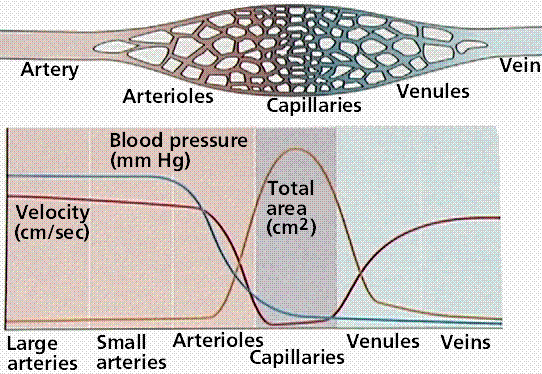- Joined
- Jun 20, 2016
- Messages
- 264
- Reaction score
- 48
I'm listing the whole mechanism & blood v comparison of the circulatory system, feel free to correct if I am wrong.
Oxygenated blood=OB
Deoxygenated blood=DOB
1) OB flows from LUNG ->relaxed LA through Pulmonary Vein
2) LA contracts->OB blood flows to relaxed LV through Mitral Valve
3) LV contracts-> OB blood goes through aorta valve to periphery through arteries
4) arteries get branched into capillaries (OB->DOB) Oxygen diffuses to necessary organs
5) Capillaries become Veins carrying DOB
6) as RA relaxes, DOB flows in through Vena Cava
7) RA contracts; RV relaxes, DOB flows into RV through tricuspid valve
8) RV contracts and pushed DOB to pulmonary artery through pulmonic valve
9) DOB goes to lung from pulmonary artery->capillaries (exchange gases) and repeats the circulatory system.
According to the continuous equation, as A increases, v decreases.
So comparing blood v:
arteries=veins<arterioles=venule<capillaries?
This is because we compare TOTAL cross-sectional area. Correct?

So here, we can see that A and v are inversely proportional due to the continuous equation (A1v1=A2v2)
As for BP, why are veins lower than arteries? Does this have to do with P1V1=P2V2? But I don't know if there is a difference in volume between the 2...
Oxygenated blood=OB
Deoxygenated blood=DOB
1) OB flows from LUNG ->relaxed LA through Pulmonary Vein
2) LA contracts->OB blood flows to relaxed LV through Mitral Valve
3) LV contracts-> OB blood goes through aorta valve to periphery through arteries
4) arteries get branched into capillaries (OB->DOB) Oxygen diffuses to necessary organs
5) Capillaries become Veins carrying DOB
6) as RA relaxes, DOB flows in through Vena Cava
7) RA contracts; RV relaxes, DOB flows into RV through tricuspid valve
8) RV contracts and pushed DOB to pulmonary artery through pulmonic valve
9) DOB goes to lung from pulmonary artery->capillaries (exchange gases) and repeats the circulatory system.
According to the continuous equation, as A increases, v decreases.
So comparing blood v:
arteries=veins<arterioles=venule<capillaries?
This is because we compare TOTAL cross-sectional area. Correct?

So here, we can see that A and v are inversely proportional due to the continuous equation (A1v1=A2v2)
As for BP, why are veins lower than arteries? Does this have to do with P1V1=P2V2? But I don't know if there is a difference in volume between the 2...
Last edited:
